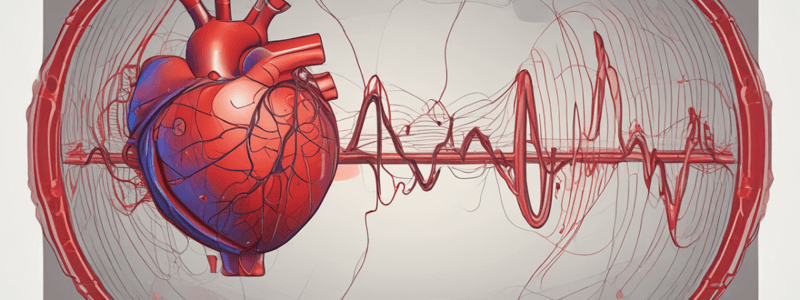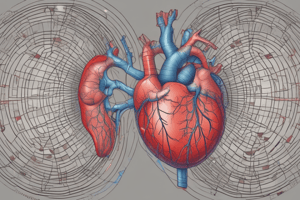Podcast
Questions and Answers
What percentage of blood flows directly into the ventricles before the atria contract?
What percentage of blood flows directly into the ventricles before the atria contract?
- 90%
- 100%
- 80% (correct)
- 60%
What is the result of atrial contraction during the cardiac cycle?
What is the result of atrial contraction during the cardiac cycle?
- 80% reduction in ventricular filling
- 20% increase in ventricular filling (correct)
- 20% reduction in ventricular filling
- 80% increase in ventricular filling
What would happen if the atria fail to function?
What would happen if the atria fail to function?
- The ventricles would stop working
- The heart would stop beating
- The ventricles would work more efficiently
- The ventricles would still work, but with reduced efficiency (correct)
During which phase of the cardiac cycle are the AV valves open?
During which phase of the cardiac cycle are the AV valves open?
What is the function of the atria in the cardiac cycle?
What is the function of the atria in the cardiac cycle?
What would be the clinical consequence of atrial failure?
What would be the clinical consequence of atrial failure?
What is the primary function of the A-V valves during systole?
What is the primary function of the A-V valves during systole?
During the isovolumetric contraction phase, what occurs in the ventricles?
During the isovolumetric contraction phase, what occurs in the ventricles?
What causes the semilunar valves to open during systole?
What causes the semilunar valves to open during systole?
What is the role of the papillary muscles in relation to the A-V valves?
What is the role of the papillary muscles in relation to the A-V valves?
What sound is produced when the A-V valves close?
What sound is produced when the A-V valves close?
During the isovolumetric contraction phase, what happens to the cardiac muscle fibers?
During the isovolumetric contraction phase, what happens to the cardiac muscle fibers?
What is the characteristic of the first heart sound (S1)?
What is the characteristic of the first heart sound (S1)?
What is the result of the ventricular pressure exceeding 80 mmHg during the isovolumetric contraction phase?
What is the result of the ventricular pressure exceeding 80 mmHg during the isovolumetric contraction phase?
What percentage of the total volume is ejected during ventricular ejection?
What percentage of the total volume is ejected during ventricular ejection?
What is the primary function of the chordae tendineae?
What is the primary function of the chordae tendineae?
What occurs during isovolumetric relaxation?
What occurs during isovolumetric relaxation?
What is the primary function of the semilunar valves?
What is the primary function of the semilunar valves?
What is the result of papillary muscle paralysis or chordae tendineae rupture?
What is the result of papillary muscle paralysis or chordae tendineae rupture?
What is the term for the fraction of the end-diastolic volume that is ejected from the ventricles during systole?
What is the term for the fraction of the end-diastolic volume that is ejected from the ventricles during systole?
What occurs during the rapid ejection phase of ventricular ejection?
What occurs during the rapid ejection phase of ventricular ejection?
What is the term for the volume of blood that remains in the ventricles after systole?
What is the term for the volume of blood that remains in the ventricles after systole?
What is the term for the total volume of blood ejected by the heart per minute?
What is the term for the total volume of blood ejected by the heart per minute?
What happens to the duration of each cardiac cycle when the heart rate increases?
What happens to the duration of each cardiac cycle when the heart rate increases?
Flashcards are hidden until you start studying
Study Notes
Cardiac Cycle - Isovolumetric Contraction
- Isovolumetric contraction is a fraction of a second long, where ventricular pressure rises abruptly, causing A-V valves to close and semilunar valves to open.
- No emptying occurs during this phase, and cardiac muscle tension increases with little to no shortening of muscle fibers.
- A-V valves close when the pressure exceeds 80 mmHg, resulting in the first heart sound (S1).
A-V Valves
- A-V valves prevent backflow of blood from the ventricles to the atria during systole.
- Valves open and close passively based on pressure gradients.
- Attached to papillary muscles by chordae tendineae, which prevent their bulging into the atria.
Cardiac Cycle - Ventricular Ejection
- When pressure is high enough, semilunar valves open, and blood is ejected out of the ventricles.
- 60% of the total volume is ejected (ejection fraction).
- 70% of the ejected blood flows during the first third of ejection (rapid ejection), and 30% during the next two-thirds (slow ejection).
Cardiac Cycle - Isovolumetric Relaxation
- At the end of systole, ventricular relaxation begins suddenly, causing a rapid decrease in pressure.
- This leads to the closing of semilunar valves, while A-V valves remain closed.
- The volume does not change during this phase (isovolumetric).
SEMILUNAR Valves
- SEMILUNAR valves prevent backflow of blood from the aorta and pulmonary arteries into the ventricles during diastole.
- They are specially constructed to resist physical stress and have smaller openings, which allows for rapid ejection.
- When SEMILUNAR valves close, the second heart sound (S2) is heard.
Cardiac Cycle - Rapid Ventricular Filling
- After systole, ventricular pressure falls, and the pressure inside the atria forces the A-V valves to open.
- Blood flows rapidly into the ventricles (80% filling) during the rapid ventricular filling phase.
Cardiac Cycle - Diastasis
- In the mid-portion of diastole, only a small amount of blood flows into the ventricles.
- Blood continues to empty from the veins into the atria and flows directly into the ventricles.
Cardiac Cycle - Atrial Systole
- Atrial systole forces blood into the ventricles, resulting in an additional 20% filling.
- Atrial contraction occurs in the fourth part of ventricular diastole.
The Cardiac Cycle
- The cardiac cycle consists of diastole ( Ventricular relaxation and filling) and systole (ventricular contraction and ejection).
- End diastolic volume is the volume of each ventricle at the end of diastole.
- Ejection fraction is the fraction of the end diastolic volume that is ejected during systole (60%).
- Stroke volume is the total volume of blood ejected by the ventricle on each beat.
- Cardiac output is the total volume ejected by the heart per minute.
Effects of Heart Rate on Cardiac Cycle
- When the heart rate increases, the duration of each cardiac cycle decreases.
- Diastole is affected more than systole, leading to incomplete filling of the cardiac chambers before the next contraction.
Studying That Suits You
Use AI to generate personalized quizzes and flashcards to suit your learning preferences.




